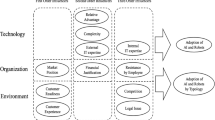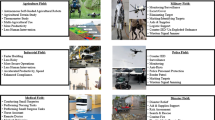Abstract
The trend in industrial automation is to move towards fast and real-time identification, further improving the high-level of accuracy that is needed to enable continuous identification and monitoring. The interest in adopting radio frequency identification (RFID) technology for use in automation systems with minimal manual involvement is increasing rapidly. RFID systems are capable of providing real-time object visibility with high accuracy enabling continuous identification and location of all items and thereby providing accurate real-time data management instead of simple snapshots. In this paper, the use of multiple reader antennas is examined against collision and interference avoidance. Also, antenna operation is studied in typical industrial environments containing metallic objects or other conducting surfaces. In addition, this paper reviews different tag antennas and their characteristics for particular item identification cases. These cases include items made of specific materials that obstruct or prevent radio wave propagation by either absorbing or reflecting them. The results given in this paper are fully applicable with practical RFID solutions.
Similar content being viewed by others
References
Rao K, Duan D-W, Heinrich H (1999) On the read zone analysis of radio frequency identification systems with transponders oriented in arbitrary directions. Proc Microwave Conf Asia Pacific 3:758–761
Keskilammi M, Salonen P, Sydänheimo L, Kivikoski M (2002) Effect of antennas on read range in RFID systems for manufacturing and logistics control. Proc of IASTED Int. Conf. on Control and Applications, Cancun, Mexico pp 2081−2085
Finkenzeller K (2003) RFID handbook 2nd edn. John Wiley & Sons Inc. West Sussex, UK
Sarma S, Brock D, Engels D (2001) Radio frequency identification and the electronic product code. IEEE Micro 21(6):50−54
Penttilä K, Engels D, Kivikoski M (2004) Passive radio frequency identification in supply chain management. Int J Robot Automat Acta 19(3):143−152
Penttilä K, Aarinen R, Sydänheimo L, Kivikoski M (2004) The evolution of a wireless RFID and a cell phone. IEEE Int symposium on communication systems, networks and signal processing. Newcastle, UK, pp 341–344
Keskilammi M, Sydänheimo L, Kivikoski M (2003) Radio frequency technology for automated manufacturing and logistics control. Part 1: passive RFID systems and the effects of antenna parameters on operational distance. Int J Adv Manuf Technol 21(10−11):769−774
Sydänheimo L, Ukkonen L, Kivikoski M (in press) Effects of size and shape of metallic objects on performance of passive radio frequency identification. Int J Adv Manuf Technol
Keskilammi M (2004) Importance of application specific antennas on passive long-range RFID system performance. Dissertation, Tampere University of Technology Publications 516, TTY-Paino, Tampere, Finland
Hansen R (1989) Relationships between antennas as scatterers and as radiators. Proc IEEE. 77(5):659−662
Pozar D (2004) Scattered and absorbed powers in receiving antennas. IEEE Antennas Propagat Mag 46(1):144−145
Appel-Hansen J (1988) Accurate determination of gain and radiation patterns by radar cross-section measurements. IEEE Trans Antennas Propagat. 27(5):640−646
Penttilä K, Keskilammi M, Sydänheimo L, Kivikoski M (in press) Radar cross section analysis for passive RFID system. IEE Proc Microwave, Antennas Propagat
Vizmuller P (1995) RF design guide: systems, circuits and equations. Artech House, Boston, USA
Reitz J, Milford F, Christy R (1962) Foundations of electromagnetic Theory. Addison-Wesley, Boston Addison-Wesley Publishing Company Inc. New York, USA
Alonso M, Finn E (1967) Fundamental university physics.vol II: fields and waves. Addison–Wesley, Publishing Company. Reading, MA, USA
Keskilammi M, Kivikoski M (2004) Using text as a meander line for RFID transponder antennas. IEEE Antennas and Wireless Propagat Lett 3:372−374
Ukkonen L, Sydänheimo L, Kivikoski M (2004) A novel tag design using inverted-F antenna for radio frequency identification of metallic objects. IEEE Sarnoff Symposium on Advances in Wired and Wireless Communication. 26−27 Apr. 2004. Princeton, NJ USA, pp 91−141
Ukkonen L, Soini M, Engels D, Sydänheimo L, Kivikoski M (2004) Effect of conductive material in objects on identification with passive RFID technology: a case study of cigarette cartoons. Int Conf on Machine Automation. 24−26 Nov. 2004 Osaka, Japan, pp 569−572
Kraus J (1950) Antennas. McGraw-Hill Internnational editions. New York, USA
Author information
Authors and Affiliations
Corresponding author
Rights and permissions
About this article
Cite this article
Penttilä, K., Keskilammi, M., Sydänheimo, L. et al. Radio frequency technology for automated manufacturing and logistics control. Part 2: RFID antenna utilisation in industrial applications. Int J Adv Manuf Technol 31, 116–124 (2006). https://doi.org/10.1007/s00170-005-0174-y
Received:
Accepted:
Published:
Issue Date:
DOI: https://doi.org/10.1007/s00170-005-0174-y




